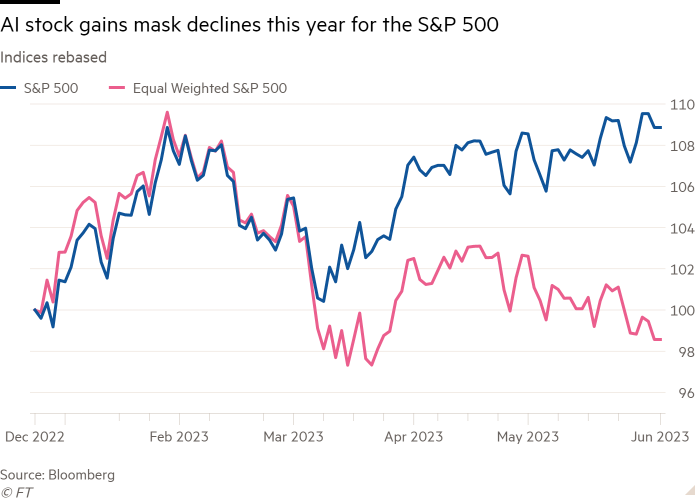By one measure at least, the US stock market has slipped into negative territory since the start of the year.
The S&P 500 Equal Weighted index, which gives equal value to each stock, has fallen 0.35 per cent since January, data from Refinitiv shows. That stands in stark contrast to the 9.5 per cent gain for the benchmark S&P 500, where companies with larger market capitalisations account for a larger share of the index.
Although bigger gaps have previously opened up between the two measures of the same stock market’s performance, “there has never been such a strong negative divergence”, said Manfred Hübner, managing director at research house Sentix.
Rapidly rising demand for the very biggest stocks explains the difference. Riding the AI wave, Nvidia, Microsoft, Alphabet, Apple, Amazon and Meta have added a total of $3.1tn in market cap terms in 2023, data from AJ Bell show. Ignoring their contribution, the S&P 500 has shed $286bn so far this year.
High quality, low-risk tech stocks may also have begun to trade like traditional haven assets such as US Treasuries and the dollar, “both of which are beset by doubt”, argued Erik Knutzen, chief investment officer multi-asset class at Neuberger Berman. “Perhaps market participants are more concerned than they look,” he said.
Stripping out volatile food and energy prices, core inflation remains stubbornly sticky, suggesting the US Federal Reserve may have to continue raising interest rates or hold them “higher for longer” to engineer a recession in the next 12 months.

Just 12 per cent of S&P 500 companies are outperforming the index on a 60-day trailing basis, the lowest level since at least 1993, according to Liz Ann Sonders, chief investment strategist at Charles Schwab.
Quoting actor Michael Caine, Sonders said the surprisingly buoyant S&P 500 now resembles a duck: “calm on the surface but paddling like the dickens underneath.”
Bull runs in the late 1990s and between 2019 and 2021 were similarly driven by a handful of the biggest companies, said Thomas Mathews, markets economist at Capital Economics.
The latter bull run slowly broadened out as investors became more confident about the state of the US economy post-pandemic, only to tail off as interest rates began to rise in 2022. Stock markets reversed sharply when the dotcom bubble burst.
“If we’re right that growth will falter later this year . . . we suspect some pain is on the way for the S&P 500, and global equities generally,” said Mathews.

